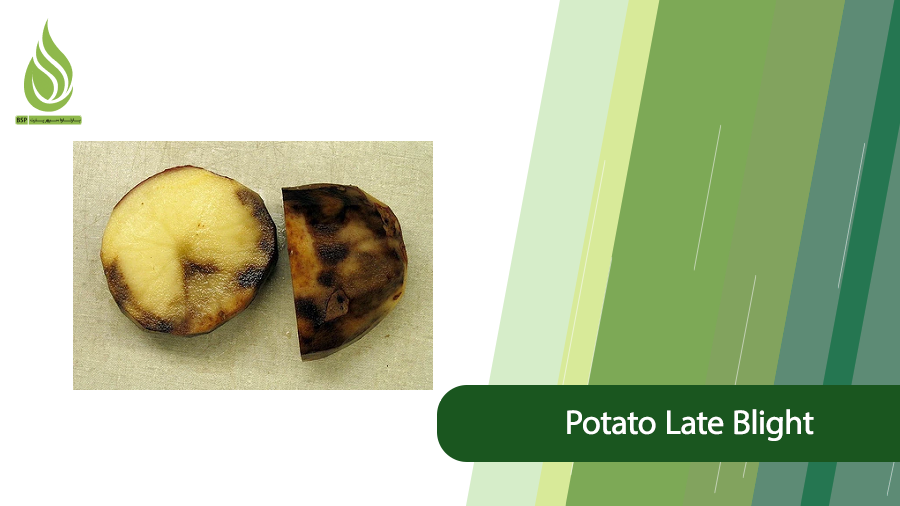
What is Potato Late Blight? How Can We Combat This Disease?
Potato late blight is one of the most serious threats to farmers and potato producers. This fungal disease rapidly damages potato fields, reducing both the quality and quantity of the crop.
In this article, we’ll explore the symptoms of late blight and discuss prevention and treatment methods. By better understanding the disease and how to combat it, farmers can protect their fields and avoid financial losses.
Introduction to Late Blight in Plants
Late blight is one of the most destructive diseases affecting potatoes and other crops. It destroys all above-ground parts of the plant—including leaves, stems, and branches—and severely damages the harvest.
The cause of potato late blight is a fungus-like organism called Phytophthora infestans. This pathogen spreads to fields via rain, wind, humans, or animals. Once inside the plant, the organism grows within the cells, absorbing nutrients through structures it sends into the plant tissue. It then produces sporangia (spore-bearing structures) that emerge from the leaves. These sporangia can be carried by wind or rain droplets, infecting neighboring plants.

The early signs of infection include blue-black spots on leaves, along with rot in stems, fruits, and foliage. The disease progresses rapidly—under favorable conditions, it can infect an entire field within ten days. Late blight is not exclusive to potatoes; crops such as tomatoes, peppers, cauliflower, broccoli, leafy greens, kale, beets, and others are also vulnerable to this pathogen.
Symptoms of Potato Late Blight
Potato late blight can severely impact crop quality and yield, making early detection critical. The first symptoms typically appear on the leaves, manifesting as irregular, brown, water-soaked lesions. In high-humidity conditions, a fuzzy white growth develops on the undersides of the leaves. As the infection advances, the lesions darken, and the leaf tissue disintegrates, leading to widespread damage.
By recognizing these symptoms promptly, farmers can take swift action to mitigate losses and protect their crops.
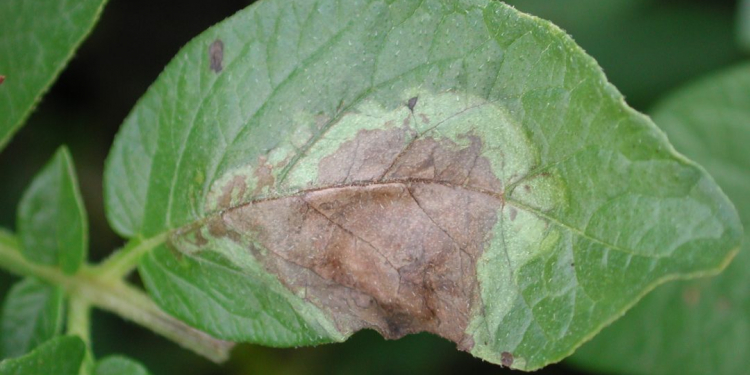
Stems infected with late blight develop brown, water-soaked lesions. The darkening typically begins at the stem tip and gradually spreads, eventually causing the entire plant to dry out. Infected stems become brittle and may snap easily at the site of the lesions.
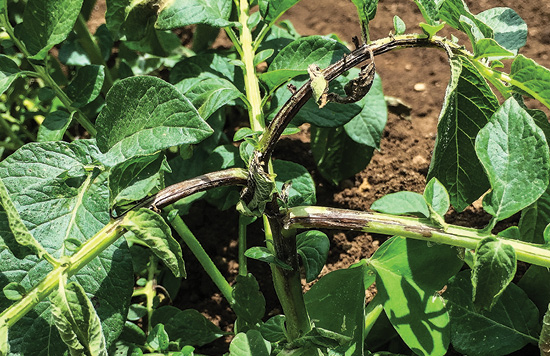
Late blight also affects potato tubers. Infected tubers develop dark brown or black internal spots, along with shallow, irregular lesions on the surface. Over time, the tubers begin to rot. After harvest, infected potatoes may emit a foul or rotten odor, rendering them unusable.
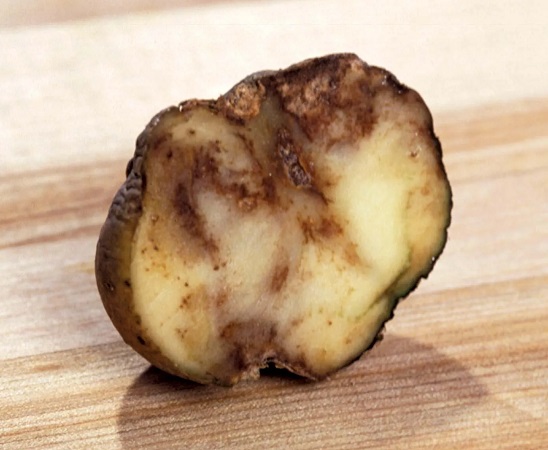
Quick identification of potato late blight symptoms enables farmers to take timely measures to control and manage the disease. Maintaining tuber quality and health is critical, and close attention to these signs is essential.
Environmental Factors Influencing Potato Late Blight
Potato late blight is driven by a combination of environmental factors that promote its spread and severity. Below, we examine these key contributors:
- Soil Moisture: Wet, waterlogged soils create ideal conditions for the pathogen (Phytophthora infestans) to thrive. Excess moisture allows the organism to penetrate potato plants more easily.
- High Temperatures: Temperatures above 25°C (77°F) accelerate pathogen activity and disease progression. In optimal conditions, the pathogen multiplies rapidly, worsening outbreaks.
- Rainfall and High Humidity: Frequent rain and humid air accelerate disease spread, especially during warm, wet seasons.
- Over-Fertilization: Overly fertilized soils, particularly those rich in organic matter, are more susceptible to fungal-like diseases.
- Poor Air Circulation: Areas with limited airflow and high humidity create a breeding ground for the pathogen.
- Lack of Crop Rotation: Repeated potato planting in the same field leads to pathogen buildup. Implementing proper crop rotation can significantly reduce this risk.
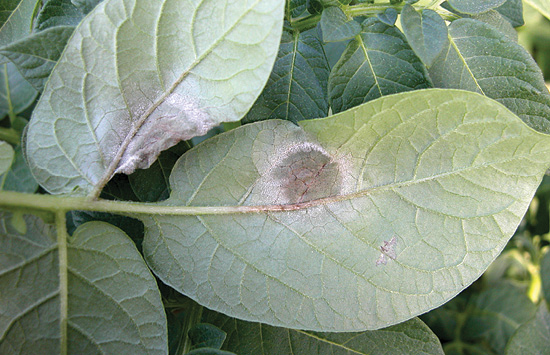
Methods to Prevent Potato Late Blight
To safeguard crops from potato late blight, farmers can adopt the following preventive measures:
- Crop Rotation: Alternating potato crops with non-host plants (e.g., grains or legumes) reduces pathogen buildup in the soil.
- Selecting Healthy Seed: Purchase certified, disease-free seeds from reputable suppliers to avoid introducing Phytophthora infestans to fields.
- Controlled Irrigation: Avoid overwatering. Opt for drip irrigation to maintain balanced soil moisture and prevent conditions that favor the pathogen.
- Proper Plant Spacing: Ensure adequate spacing between plants to improve airflow, reduce humidity, and minimize disease spread.
- Weed Management: Remove weeds regularly, as they can harbor pathogens and compete with crops for nutrients.
- Sanitation Practices:
- Clean farming tools and equipment thoroughly after use to prevent cross-contamination.
- Clear fields of plant debris post-harvest to eliminate potential sources of infection.
- Burn or properly dispose of infected plant material to destroy spores.
- Regular Monitoring: Inspect crops frequently for early symptoms (e.g., lesions, wilting). Immediate action can curb outbreaks.
- Tuber Disinfection: Treat seed tubers with antifungal solutions or disinfectants before planting to reduce disease transmission.

Combating
Effectively managing potato late blight requires practical strategies to reduce disease severity and preserve crop quality. Below are actionable solutions:
- Regular Monitoring: Frequently inspect fields for early signs of infection (e.g., lesions, discoloration). Promptly address any abnormalities in leaves or tubers.
- Effective Fungicides:
- Use approved fungicides and bactericides to suppress the pathogen. Products containing Mancozeb or Copper Hydroxide are often effective against late blight.
- Consult local farmers or agricultural experts for region-specific chemical recommendations and proper application guidelines.
- Remove Infected Plants: Immediately uproot and dispose of diseased plants (burn or bury away from fields) to halt pathogen spread.
- Moisture and Irrigation Management:
- Avoid overwatering. Ensure soil is well-drained and not waterlogged.
- Refrain from heavy irrigation during early growth stages or hot midday periods.
- Balanced Nutrition:
- Avoid excessive nitrogen-based fertilizers (e.g., ammonium sulfate fertilizer), which promote lush foliage and create humid conditions ideal for fungal growth.
- Use calcium-rich fertilizers to strengthen tuber cell walls and potassium-based fertilizers to enhance skin resistance.
- Incorporate micronutrient supplements to boost overall plant health.
Pro Tip: Combine these tactics with preventive measures like crop rotation and sanitation for a holistic defense against late blight. Consistent implementation can save your harvest and reduce reliance on chemicals!
